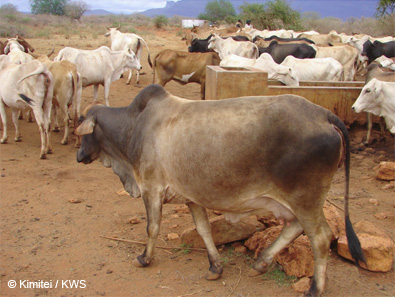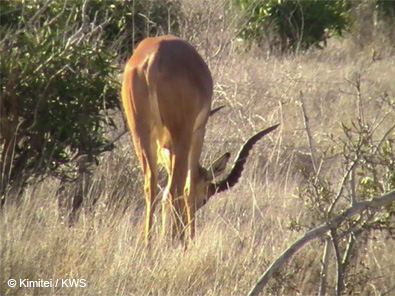Here is the latest update from EDGE Fellow Kimitei, who is monitoring the translocated hirola antelope population in Tsavo National Park, southern Kenya.
Hirola population is staggering in a point. This automatically brings in a prediction on the reasons why it is so. Last blog I gave out some possible reasons why this is happening. I promised to continue with the predictions.
Taita district where part of it hosts Tsavo East National Park is fattening zone for beef cattle for export. The livestock are grazed within the hirola range. The amazing thing is that the cattle are not treated after all, since the area is thought to be disease free. However, rinderpest eruption might be in underground phase despite not detected yet. In early 90’s the same had broke out. The associate species (grant gazelles) have been sighted with a skin disease though no hirola has been sighted with the disease. Further more, all sighted hirola are healthy from observation of their smooth and clean coat.
Localized ranging behaviour might be another cause. Most of the hirola groups and lone individuals have been sighted to occupy specific sites all year round. Though they have local movements but rarely they go beyond 10 kms from the site. This localization might lead to lack of basic requirements due to changes in weather condition. This therefore expose them to hazard conditions that may affect their behavioural ecology.
Group male abnormality in the sense that, the male does not play roles of a leader in the group. This might have been caused by lack of mechanical aggression from other bachelor males. In fact, the bachelor males are far away from the groups which do not bring any threat to the group male. The group male might enjoy the situation up to a point that he cannot even mate with the mature females in the group since it is normally that all are his. Females might come on heat but the male does not serve. Sometimes females might be many for him to serve and thus some breeding season goes without all females served.
The genetic make up of hirola might be having a problem. Hirola are not vigilant animals like their associate species (grant gazelles, cokes hartebeest, zebra and Oryx). When approached, they run 5-7 steps, relax, and carry on with walking or grazing as if nothing is happening. Their social organization is under standard compared with other species. This deformity may expose them to poaching, over predation, not having survival for the fittest.
If you would like to support the conservation work of EDGE Fellows such as Kimitei you can raise funds by becoming an EDGE Champion, or you can donate here.

